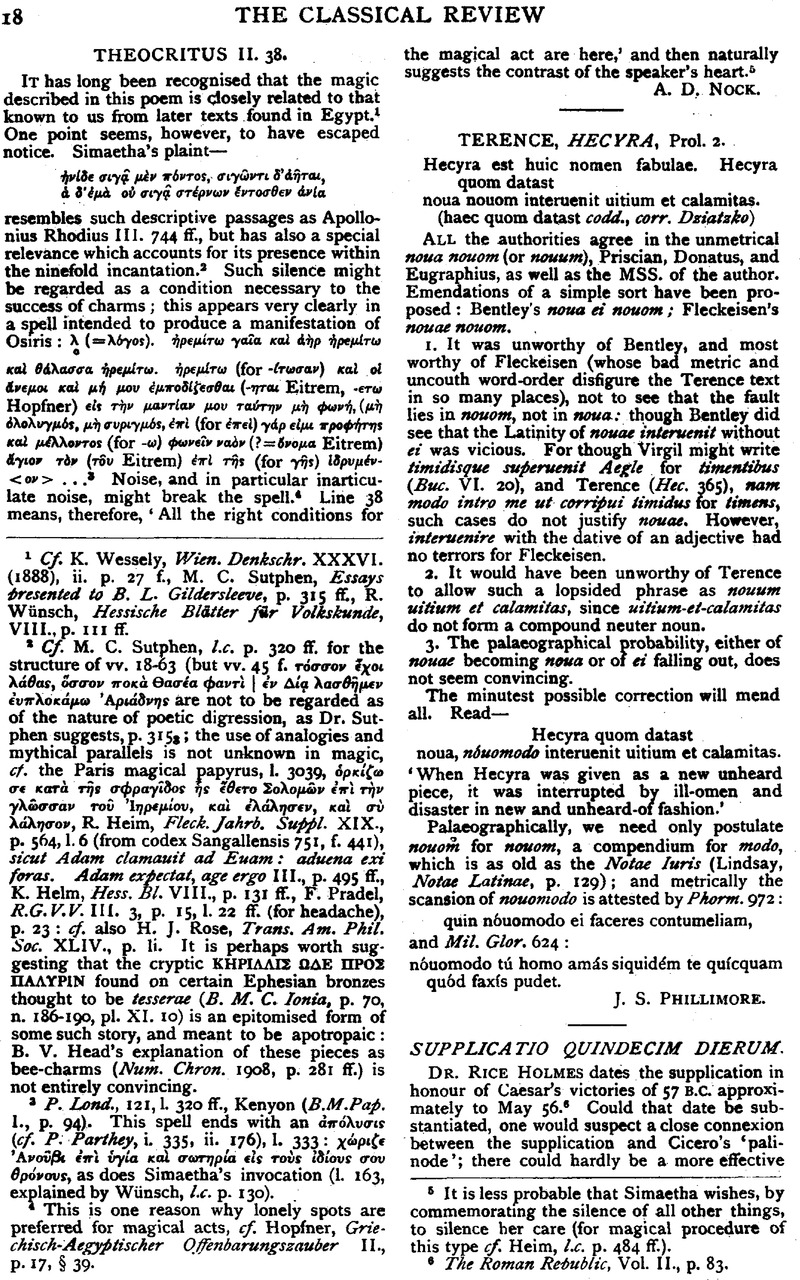No CrossRef data available.
Article contents
Abstract

- Type
- Review Article
- Information
- Copyright
- Copyright © The Classical Association 1925
References
1 Cf. Wessely, K., Wien. Denkschr. XXXVI. (1888), ii. P. 327 f.Google Scholar, Sutphen, M. C., Essays presented to B. L. Gilderslecve, P. 315 ff.Google Scholar, Wünsch, R., Hessische Blätter fūr Volkskunde, VIII., P. III ff.Google Scholar
2 Cf. M. C. Sutphen, l.c. P. 320 ff. for the structure of vv. 18–63 (but vv. 45 f. τόσσoν εχoι λάθας, óσσoν φoκà Θασέα φαντì | έν Δία λασθἢμεν ένφλoκάμω ‘Αριάδόνης are not to be regarded as of the nature of poetic digression, as DR. Sutphen suggests, P. 3152; the use of analogies and mythical parallels is not unknown im magic, Cf. the Paris magical papyrus, I. 3039, òρκίζω σε κατà τἠς σΦραγîόoς νς έθετo Σoλoμων έφì τήν γλωσσαν τoἠ ‘Iηρεμίoν, καί έλάλησσεν, καì σν λάλησoν, R. Heim, Fleck. Jahrb. Suppl. XIX., P. 564, 1. 6 (from codex Sangallensis 751, f. 441), sicut Adam clamauit ad Euam: aducna exi foras. Adam expectat, age ergo III., p. 495 ff., K. Helm, Hess. Bl. VIII., P. 131 ff., F. Pradel, R.G.V.V. III. 3, P. 15, 1. 22 ff. (for headache), p. 23: cf. also H. J. Rose, Trans. Am. Phil. Soc. XLIV., p. li. It is perhaps worth suggesting that the crypict KHPIΛΛIΣ ΩΔE ΠοΣ ΠΛΛγPIN found on certain Ephesian bronzes though to be tesserae (B. M. C. Ionia, P. 70, n 186–190, pl. XI. 10) is an epitomised form of some such story, and meant to be apotropaic: B. V. Head's explanation of these pieces as bee-charms (Num. Chron. 1908, p. 281 ff.) is not entirely conving.
3 P. Lond., 121, 1.320 ff., Kenyon (B.M.Pap. I., P. 94). This spell ends with an ⋯π⋯λυσις (Cf. P. Parthey, i. 335, ii. 176), 1. 333: χώριζε ‘Ανoνβι ⋯π⋯ ὑγ⋯α ε⋯ς τοὐς ⋯δ⋯ους λου θρ⋯νους, as does Simaetha's invocation (1. 163, explained by Wünsch, l.c. p. 130).
4 This is one reason why lonely spots are preferred for magical acts, cf. Hopfner, Griechisch-Aegyptischer Offenbarungszauber II., p. 17, § 39.
5 It is less Probable that Simeatha wishes, by commemorating the silence of all other things, to silence her care (for magical procedure of this type cf. Heim, l.c. p. 484 ff.).
6 The roman Rebublic, Vol. II., p. 83.Google Scholar




